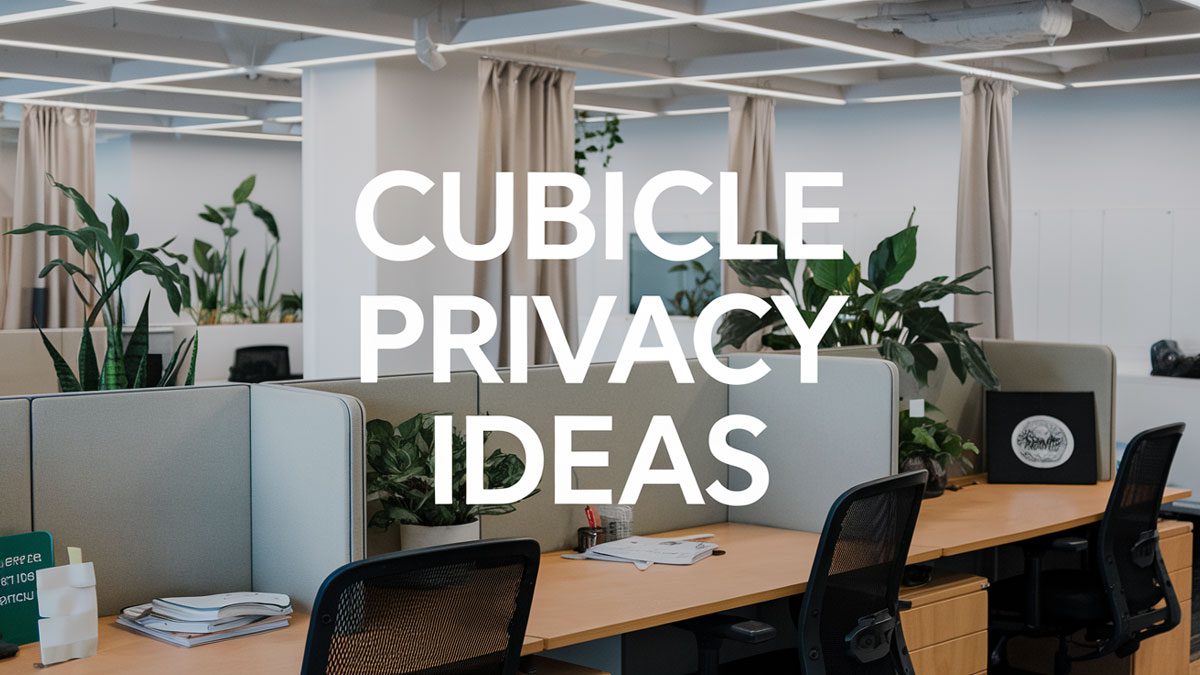Working in an open office or shared workspace can be distracting. Noise, visual clutter, and constant interruptions can make it hard to focus.
If you’re looking for ways to create a private, peaceful workspace within your cubicle, you’re in the right place.
This guide will provide 10 actionable ideas to improve your cubicle privacy, helping you stay focused and comfortable at work.

| Privacy Solution | How It Helps | Best For |
|---|---|---|
| Desk Dividers | Blocks visual distractions and adds personal workspace separation. | Reducing interruptions from nearby coworkers. |
| Privacy Screens | Creates an enclosed feel while maintaining a professional look. | Employees who need visual privacy without altering cubicle walls. |
| Plants as Dividers | Acts as a natural screen while improving air quality and aesthetics. | Eco-conscious workers looking for privacy with a touch of nature. |
| Noise-Canceling Headphones | Blocks out office noise and signals to others that you’re focused. | Employees who need to concentrate in noisy environments. |
| Monitor Privacy Screens | Prevents people from seeing your screen from side angles. | Protecting sensitive work information from prying eyes. |
| Open/Close Availability Sign | Lets colleagues know when you’re available or need privacy. | Minimizing unnecessary interruptions during deep work. |
| Extended Cubicle Walls | Increases cubicle height for greater visual and sound privacy. | Employees in open-office layouts needing maximum separation. |
| Strategic Desk Placement | Reduces distractions by facing the desk away from high-traffic areas. | Workers who can reposition their setup for better privacy. |
| Sound Masking Devices | Creates white noise to cancel out background office chatter. | Open-office workers struggling with noise distractions. |
| Personalized Cubicle Setup | Adds soft lighting, artwork, and decor for a cozy, private feel. | Employees wanting a comfortable and personalized workspace. |
1. Use Desk Dividers to Block Visual Distractions
One of the simplest ways to enhance privacy in a cubicle is by adding desk dividers. These create a barrier between your space and nearby coworkers, reducing visual distractions.

💡 How to Implement:
- Use freestanding or clamp-on dividers that attach to your desk.
- Opt for fabric or frosted acrylic panels for added sound absorption.
- Consider extending cubicle walls with panel extenders for more privacy.
📌 Pro Tip: Some companies offer customizable dividers that allow you to pin notes, calendars, or décor, making them functional and stylish.
2. Add a Cubicle Privacy Screen or Curtain
If your cubicle feels too open, adding a privacy screen or curtain can make a significant difference. These soft barriers help create a personal workspace without violating office policies.

💡 How to Implement:
- Use a cubicle-mounted retractable curtain for flexible privacy.
- Try portable standing screens that you can reposition as needed.
- Choose neutral or professional colors to maintain a clean office look.
🚧 Drawback: Some offices may not allow curtains for fire safety reasons, so check company policies first.
3. Use Plants as Natural Dividers
Plants are not just for decoration—they can also act as privacy barriers while improving air quality and reducing office noise.

💡 Best Plants for Privacy:
- Snake plants: Tall and low-maintenance.
- Peace lilies: Help filter air and reduce noise.
- Bamboo palms: Dense foliage for a solid visual barrier.
📌 Pro Tip: Arrange multiple plants along the edge of your cubicle to create a mini green wall for better privacy.
4. Wear Noise-Canceling Headphones to Block Out Sound
Noise distractions are one of the biggest privacy concerns in an open office. A pair of noise-canceling headphones can help create an instant quiet zone.

💡 Best Uses:
- Listening to white noise or calming music.
- Blocking out coworkers’ conversations.
- Signaling to others that you are focused and unavailable.
🚧 Drawback: While effective, headphones can sometimes isolate you from team communication, so balance their use as needed.
5. Install a Monitor Privacy Screen to Protect Sensitive Work
If you handle confidential information, a monitor privacy screen is essential. These screens prevent others from seeing your screen at an angle, ensuring your work remains private.

💡 How to Choose:
- Magnetic or adhesive options for easy installation.
- Blue light filtering screens for added eye protection.
- Anti-glare models to reduce screen reflection.
📌 Pro Tip: A wider privacy screen (30-60 degrees) ensures that only you can see the display directly in front.
6. Use Open/Close Indicators to Control Interruptions
A simple availability sign on your cubicle can reduce unnecessary distractions from coworkers.

💡 Options to Consider:
- “Do Not Disturb” signs when working on important tasks.
- Availability sliders to let others know when you’re open for discussion.
- Personalized messages to keep things professional and friendly.
🚧 Drawback: Not everyone may respect the sign, so pairing this with other privacy methods can be more effective.
7. Extend Cubicle Walls for Maximum Privacy
If your cubicle walls are too low, you can add height extenders to improve privacy.

💡 How to Implement:
- Use clip-on extenders that match the existing cubicle material.
- Opt for acoustic panels to reduce noise along with visual privacy.
- Request higher partitions from your employer if feasible.
📌 Pro Tip: Many companies allow temporary panel extenders, so check if your workplace provides them before purchasing your own.
8. Position Your Desk Strategically to Minimize Disruptions
The placement of your desk within your cubicle can make a big difference in privacy.

💡 Best Desk Positions for Privacy:
- Face away from high-traffic areas.
- Keep your monitor against the wall to prevent others from looking over.
- If possible, angle your workspace to avoid direct eye contact with passersby.
🚧 Drawback: Desk positioning options may be limited depending on office layout.
9. Implement Sound Masking to Reduce Office Noise
Sound masking systems help reduce background noise by introducing soft ambient sounds.

💡 How to Implement:
- Use white noise machines or apps like Noisli.
- Set up desktop sound barriers with fabric or cork boards.
- Ask your company about sound masking technology in shared workspaces.
📌 Pro Tip: Soft ambient sounds (rain, fan noise, or instrumental music) work best for improving focus.
10. Personalize Your Space to Feel More Comfortable
Privacy isn’t just about blocking noise or distractions—it’s also about making your cubicle feel like your own personal space.

💡 Ideas for Personalization:
- Add calming artwork to reduce stress.
- Use a small bookshelf or storage unit to create a physical boundary.
- Set up a desk lamp with warm lighting for a cozy feel.
🚧 Drawback: Keep personal items professional and minimal to comply with office policies.
Wrapping Up: Your Next Steps for a More Private Cubicle
Improving cubicle privacy can significantly boost productivity, reduce stress, and create a more comfortable work environment.
🔹 Top Takeaways:
- Use desk dividers, screens, and plants for visual privacy.
- Block out noise with sound masking and headphones.
- Protect digital privacy with monitor filters.
- Control interruptions with availability signs.
✅ Final Tip: Experiment with a combination of these methods to find what works best for your office setup.

